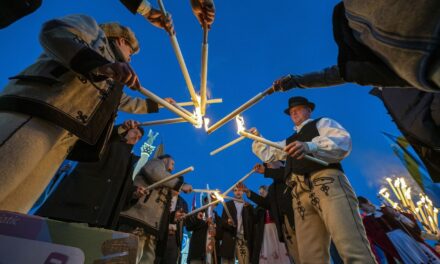In an open letter, local representatives, researchers and promoters of the material and cultural heritage of the ethnographic region of Central Transylvania object to the appropriation of one of the samples of the Kalotaszeg written embroidery, after the Mango fashion store used one of the samples in its new collection without attribution.
The open letter was published on Thursday by the Bucharest-based La blouse roumaine IA Association on its social page. In addition to popularizing the embroidered shirt of the Romanian national costume, the NGO spoke out against the unmarked use of Romanian national costume motifs on several occasions. A few days ago, attention was drawn to the fact that one of the embroidered jackets of the new collection of the Mango fast fashion store shows a pattern of the Kalotaszeg written stitchery.
The open letter, published in English, Romanian and Hungarian, was signed by several Hungarian, Romanian and foreign specialists researching the folk art of Kalotaszeg - folk artists, ethnographers, art historians, designers, several members of the Kalotaszeg Bokréta Cultural Association, and local women who still live the written embroidery. In it, they state: they consider the procedure of the Mango fast fashion store unacceptable.
View this post on Instagram
Reminder: the ethnographic region of Kalotaszeg includes around 40 settlements in Cluj and Szilágy counties, the main shapers of its rich cultural heritage are Hungarians and Romanians, both ethnicities have their own distinctive costumes and architecture.
They point out: the patterns belong to the most well-known and one of the most widespread types of Hungarian folk sewing, they have hundreds of years of history and pattern collections, and early pieces from the first half of the 19th century are preserved in museums.
They are well recognizable, they were mainly used to decorate home textiles, and can also be found on some pieces of national costume. The unique group of motifs also has a rich English literature, which the unauthorized users could have known, they wrote.
" We, the members of the Kalotaszeg community and the researchers of the landscape unit, reject this type of self-serving appropriation of the written word, which does not take into account its history, does not indicate its source, and disregards several centuries of knowledge," the open letter states. According to the signatories, it is gratifying that the values of Kalotaszeg are being noticed abroad, but the use of the model treasure is considered acceptable only if the community of Kalotaszeg is named as its creator.
Therefore , we ask that the commercial use or modification of any element of traditional tailoring and costumes only takes place after consultation with the community. Rework should be done while respecting the authenticity and integrity of the motifs used, as they are Kalotaszeg's cultural heritage!" he nails it. Romanian and foreign political decision-makers are invited to take action to protect cultural heritage.
It is not the first time in Romania that there has been outrage over the unethical procedure of international fashion brands affecting folk art values. In June, the La blouse roumaine IA Association said that Louis Vuitton had copied the sample of the Romanian women's shirt from the Sibiu region without reference. In the matter, the Romanian Minister of Culture also spoke in defense of the association. In 2017, the fashion house Dior copied - without reference - the pattern of the Romanian folk costume of Beius.
MTI
Cover image: La Blouse Roumaine













